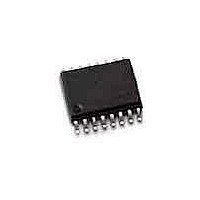IES5528T Hendon Semiconductors, IES5528T Datasheet - Page 3

IES5528T
Manufacturer Part Number
IES5528T
Description
Triacs Phase Controller
Manufacturer
Hendon Semiconductors
Datasheet
1.IES5528T.pdf
(14 pages)
Specifications of IES5528T
Gate Trigger Current (igt)
80 mA
Mounting Style
SMD/SMT
Package / Case
SO-16
Maximum Operating Temperature
+ 85 C
Minimum Operating Temperature
- 40 C
Lead Free Status / RoHS Status
Lead free / RoHS Compliant
6.2
The reset circuit ensures that trigger
pulses are not produced until V
reached its maximum value and C1 is
fully charged. The input SAW (pin14)
to the saw-tooth generator is also
held at a low state until the reset
threshold has been reached.
During start-up the reset holds the
input pins to the difference amplifier,
IC+ (pin 5) at a high state and IC-
(pin 6) at a low state. As a result,
functions such as soft and hard start
while phase firing can be realised.
The reset circuit should not reactivate
unless the voltage across the supply
capacitor (C1) drops below
approximately 7V.
6.3
The IES5528 contains a zero-
crossing detector to produce pulses
that coincide with the zero crossings
of the mains voltage, minimising RF
interference and transients on the
mains supply.
In a static switch application (see
figure 7) where the load to be driven is
purely resistive, the synchronization
voltage is obtained directly from the
mains via a resistor. This ensures
trigger pulses start shortly before, and
end shortly after each zero-crossing
of the mains voltage. Triac conduction
is maintained through the mains
voltage zero-crossing, minimising
triac switching noise.
If the load contains an inductive
component, the synchronization will
be produced by the internal gate
sense circuit rather than the
zero-crossing detector. In this case a
phase control circuit is used such as
that in figure 8. The triac is triggered
immediately following zero-crossing
of the phase-shifted load current.
2009 Nov 02, Revision 8.1
Power On Reset
Zero Crossing Detector
EE
has
6.3.1
The pulse width control input PW
(pin 1) allows adjustment of the pulse
width at output XOUT (pin 2). This is
done by choosing the value of
external synchronization resistor Rz
between PW and the AC mains.
The pulse width can be determined
using the following formula:
The above formula is simplified and
holds true for small values of PW
(PW < 2ms). The error at PW = 2ms is
approximately 1.5%.
6.3.2
Output XOUT, which produces
negative-going output pulses, is an
n-p-n open-collector output that for
some applications may require an
external pull-up resistor connected to
V
6.3.3
Input XDIS can be used to disable the
zero-crossing detector and inhibit the
synchronised pulses provided by
XOUT. This is done by injecting a
current into XDIS, typically by
connecting it via a 1MΩ resistor to
V
to the base on an n-p-n transistor
referenced to V
should be connected directly to V
XDIS must never be left floating.
6.4
6.4.1
IC+ and IC− (pins 5 and 6) are
differential inputs of the comparator or
differential amplifier, with QC+ and
QC− (pins 4 and 7) as complementary
outputs. QC+ will be HIGH and QC−
will be LOW when IC+ is higher than
IC−.
The outputs are open collector n-p-n,
and therefore require external pull-up
PW
CC
CC
.
. Input XDIS is connected directly
=
Difference Amplifier
⎛
⎜
⎝
IC+, IC-, QC+, QC-
PW
XOUT
XDIS
----------------------------------------------------- -
V
Phase Controller and Triac Triggering IC
mains pk
1
EE
×10
(
, and when not used
3
–
)
5
⋅
π f
⋅
Rz
⋅
mains
⎞
⎟
⎠
s
EE
.
resistors to realise a “high”. When not
used these outputs can be left open
circuit.
6.4.2
The comparator contains a p-n-p
current mirror source (referenced to
V
of DIFFEN (pin 3). The current drawn
from pin 3 determines the drive for the
comparator outputs and has an input
to output minimum gain of 50.
Typically this current is provided by a
resistor connected between DIFFEN
and the negative supply rail V
6.5
The saw-tooth generator may be
used to produce bursts of trigger
pulses, with the net effect that the
load is periodically switched on and
off.
With a time-proportional switch, the
ramp voltage produced by the
saw-tooth generator serves to provide
the repetition frequency of load
switching that can be adjusted with
the control voltage.
In phase control, the flyback of the
saw-tooth is used as the drive signal
for generating the trigger pulse.
6.5.1
The firing burst repetition time is
usually determined by an external
resistor and capacitor connected to
the saw-tooth generator trigger input
SAW (pin 14). The capacitor (C3)
connected to SAW is charged via R2
connected to Vcc, and discharged via
an internal 10k resistor.
R2 should not be less than 390kΩ.
Repetition rate and gate pulse width
can be set by selecting a suitable
value for R2 and C3. See figures 3
and 4 for an easy component
selection guide.
When not used, SAW can be left
disconnected.
CC
) that is activated by a current out
Saw-tooth Generator
DIFFEN
SAW
Product Specification
IES5528
EE















